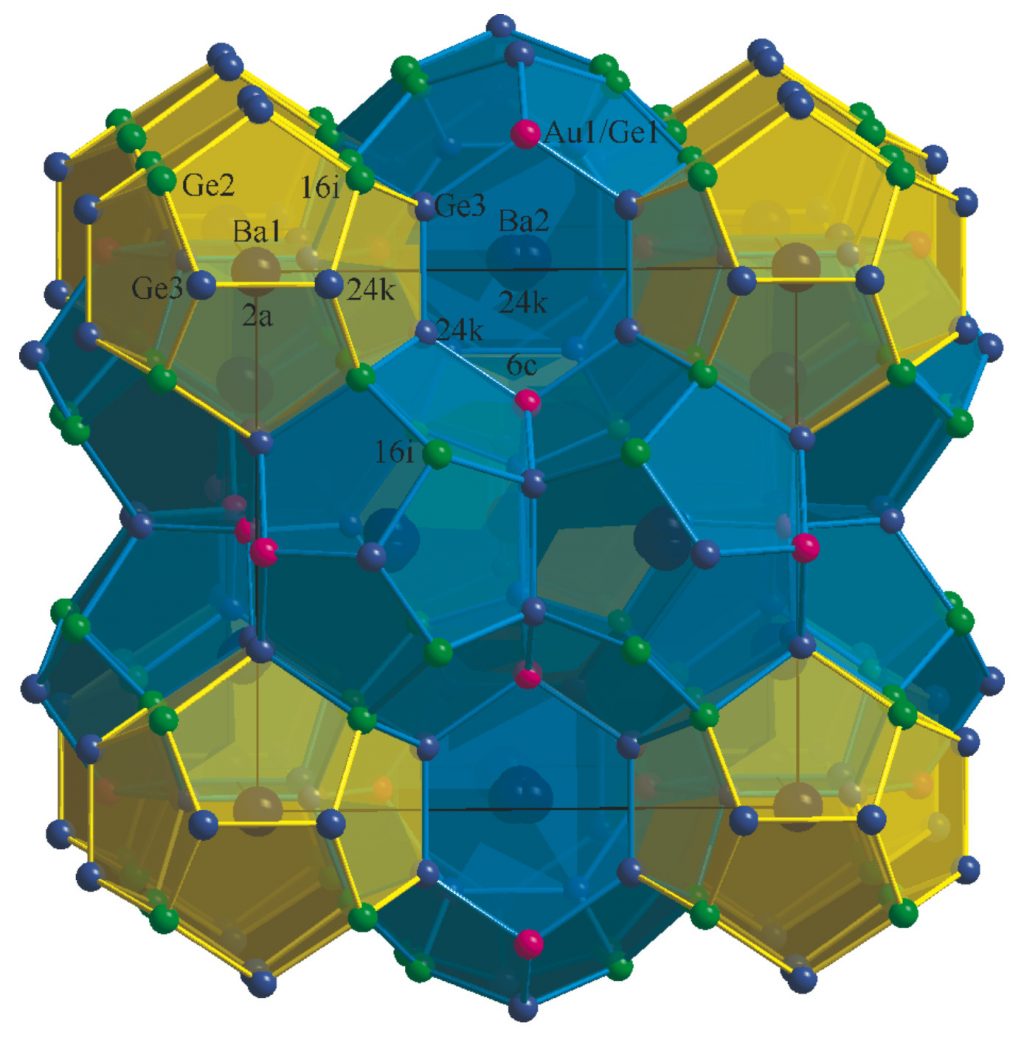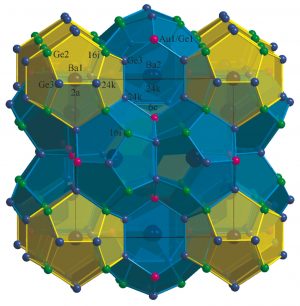Neutron experiments conducted by the Institut Laue-Langevin (ILL) and CNRS researchers, and performed on the neutron time-of-flight spectrometer (IN5@ILL) and 2T triple axis spectrometer at the Laboratoire Léon Brillouin (LLB), provide a direct quantitative measurement of phonon lifetimes in polymeric cage molecules, giving a novel picture of thermal conductivity in complex materials.
This study highlights the importance of neutron techniques in overcoming the challenging task of accessing and therefore successfully measuring phonon lifetimes.
The engineering of thermal conductivity in semiconducting materials is a central issue in the development of modern nano- and microtechnologies. Low thermal conductivity is important in materials used in technology products, as it provides thermal insulation and thus reduction of heat transfer, ensuring the products do not overheat.
Some representative of the clathrates family, complex chemical substances containing cages that trap atoms, are particularly important to study in this context as they have a range of important applications. Their thermoelectric properties make them very effective for harvesting wasted heat and converting it into electricity. To date, little is known about the exact mechanism underpinning the low thermal conductivity observed in complex structures such as clathrates.
Thermal energy is mainly carried by atomic vibrations called phonons, which are quasiparticles travelling with the sound velocity. Heat propagation and conductivity is directly related to the time a phonon travels in a material before it collides with defects or other phonons. This characteristic time is called the phonon lifetime. As such, understanding individual phonon properties is also fundamental for applications such as waste heat recovery through thermoelectric conversion. Shortening phonon lifetimes achieves low thermal conductivity, and this is a strategy which has led to extensive research around the ‘phonon engineering’ of thermoelectric materials.

Phonon lifetime is one of the key parameters for quantifying thermal conductivity, but accessing and measuring it is extremely challenging both experimentally and theoretically. The experimental challenge is due to the limits of instrumental capabilities; the resolution achieved by state-of-the-art experimental techniques is too limited for this goal. To date, no experimental evidence of a marked reduction in phonon lifetimes in clathrates has been found with inelastic neutron or X-ray scattering techniques. Nevertheless, there has been considerable progress recently with computational methods for semiconductors with simple structures. To match these advances, it is necessary to validate theoretical predictions by experimentally measuring the lifetime of individual phonon states.

The background illustrates the periodic structure of the clathrates with large cages highlighted in white. The period, equal to 1 nm, is shown by the white square (bottom left). The temperature colored curved are phonon dispersion curves, as obtained from inelastic phonon scattering measurements, from which the life time of phonons can be obtained. The sinusoid illustrates the way a phonon with a period of 2 nm propagates in a large single clathrate crystal, with exponentially decaying amplitude. The lifetime corresponds to the time when the phonon amplitude is reduced by a factor 3.
A multi-partner study published today in Nature Communications has addressed phonon lifetime measurement challenges using inelastic neutron scattering (INS) and neutron resonant spin-echo (NRSE) experiments conducted at the Institut Laue Langevin (ILL) in Grenoble, and Laboratoire Léon Brillouin (LLB) Saclay, France. Whereas the “glass-like” thermal conductivity of the clathrate Ba7.81Ge40.67Au5.33 has frequently been associated with a short phonon lifetime, this study measured for the first time to date a very long phonon lifetime using a large single crystal sample of high quality. The study also reveals a dramatic reduction of the number of phonons carrying heat, as a result of structural complexity, allowing a simple and general explanation of the low thermal conductivity of complex materials.
This study was a collaboration between the ILL, Université Grenoble Alpes, Institute of Light and Matter at the University of Lyon, National Centre for Scientific Research (CNRS), French Alternative Energies and Atomic Energy Commission (CEA), Institute of Materials Science and Technology and Institute of Solid State Physics at the Vienna University of Technology, Max Planck Institute for Chemical Physics of Solids in Dresden, Physikalisches Institut at Goethe University, Institute of Physics at Slovak Academy of Sciences, and the LLB.
Reference:
Direct measurement of individual phonon lifetimes in the clathrate compound Ba7.81Ge40.67Au5.33 ,
P.-F. Lory, S. Pailhès, V. M. Giordano, H. Euchner, H.D.Nguyen, R. Ramlau, H. Borrmann, M. Schmidt, M. Baitinger, M. Ikeda, P. Tomeš, M. Mihalkovič, C. Allio, M. R. Johnson, H. Schober, Y. Sidis, F. Bourdarot, L. P. Regnault, J. Ollivier, S. Paschen, Y. Grin & M. de Boissieu, Nature Communications, 8 (2017) 491.
Collaboration :
- Pierre-François Lory, Mark Robert Johnson, Helmut Schober & Jacques Ollivier : Institut Laue-Langevin, Grenoble, F-38000, France
- Pierre-François Lory & Marc de Boissieu : University Grenoble Alpes, CNRS, Grenoble-INP, SIMaP, F-38000, Grenoble, France
- Stéphane Pailhès & Valentina M. Giordano : University Lyon, University Claude Bernard Lyon 1, CNRS, Institute of Light and Matter, F-69622, Villeurbanne, France
- Holger Euchner : Institute of Materials Science and Technology, Vienna University of Technology, 1040, Vienna, Austria
- Hong Duong Nguyen, Reiner Ramlau, Horst Borrmann, Marcus Schmidt, Michael Baitinger & Yuri Grin : Max-Planck-Institut für Chemische Physik fester Stoffe, 01187, Dresden, Germany
- Matthias Ikeda, Petr Tomeš & Silke Paschen : Institute of Solid State Physics, Vienna University of Technology, 1040, Vienna, Austria
- Marek Mihalkovič : Institute of Physics, Slovak Academy of Sciences, 84511, Bratislava, Slovakia
- Céline Allio : Physikalisches Institut, Goethe-University, 60438, Frankfurt, Germany
- Helmut Schober : University Grenoble Alpes, UFR PhITEM, F-38000, Grenoble, France
- Yvan Sidis : Laboratoire Léon Brillouin, CNRS, CEA, UMR-12, 91191, Université Paris-Saclay, France
- Frédéric Bourdarot & Louis Pierre Regnault : University Grenoble Alpes, CEA, INAC, F-38000, Grenoble, France
Contact LLB : Yvan Sidis (LLB) .


